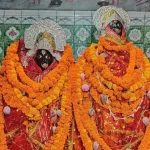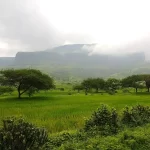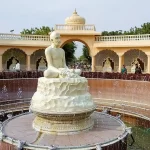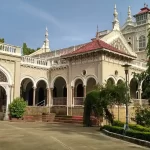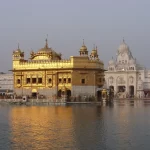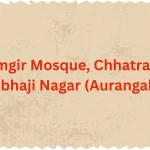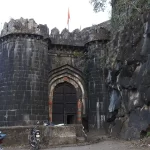“Ready to experience Pune’s spiritual soul? Plan your visit to Kasba Ganapati today and immerse yourself in centuries of devotion!”
➤ Introduction
Pune, a city synonymous with Maratha valour and modern innovation, cradles a spiritual gem at its core: the Kasba Ganapati Temple. Revered as the Gramadevata (Presiding Deity) of Pune, this temple isn’t just a religious landmark—it’s the heartbeat of the city’s cultural identity. From its humble origins as a tiny idol to its current grandeur, Kasba Ganapati embodies Pune’s resilience, unity, and timeless devotion. Kasba Ganpati is also one of the
5 Manache Ganpati in Pune.
In this comprehensive guide, we unravel the temple’s layered history, architectural marvels, and its pivotal role in shaping Maharashtra’s socio-cultural fabric. Whether you’re a pilgrim, history buff, or curious traveler, discover why this temple has captivated hearts for over four centuries.
Also Read
Tulshibaug Ganapati – Pune’s Majestic Fourth Manacha Ganpati
➤ Section Breakdown:
❉ Historical Saga: From Jijabai’s vision to Bal Gangadhar Tilak’s nationalist movement.
❉ Architectural Splendor: A blend of Maratha and Hemadpanthi styles.
❉ Festival Fever: The Ganesh Chaturthi spectacle.
❉ Travel Toolkit: Distances from major cities, itineraries, and local gems.
❉ Cultural Deep Dive: Demographics, economy, and interviews with locals.
❉ FAQs: Everything you need to know before visiting.
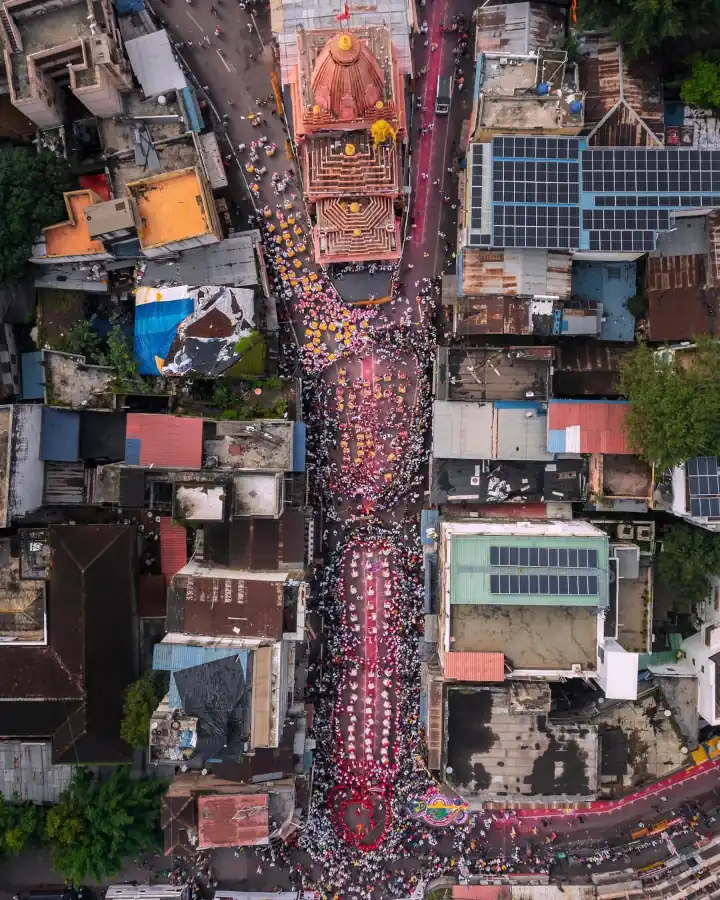
Kasba Ganapati: Pune’s Eternal Spiritual Gem – Where Faith Meets History: Discover Pune’s Beloved Guardian
1. The Historical Saga: Faith, Politics, and Patriotism
➨ Origins in the 17th Century
The temple’s story begins in 1630 when Jijabai Bhosale, mother of Chhatrapati Shivaji Maharaj, arrived in Pune. Local lore recounts that shepherd boys discovered a self-manifested (Swayambhu) Ganesh idol, no larger than a rice grain, near the riverbank. Jijabai, recognizing its divinity, commissioned a temple here, making Kasba Ganapati Pune’s oldest Ganesh shrine.
➨ Lokmanya Bal Gangadhar Tilak’s Revolutionary Vision
In 1893, freedom fighter Lokmanya Bal Gangadhar Tilak transformed Ganesh Chaturthi into a public festival to unite Indians against British rule. He declared Kasba Ganapati the first idol to be immersed, resolving rivalries and cementing its status as Pune’s spiritual anchor. Today, this tradition continues, drawing millions during the 10-day festival.
➨ Did You Know?
❉ The idol’s size grew over time due to layers of Raktachandan (Red Sandalwood) applied during rituals.
❉ Pre-1630 records mention a “Moreshwar Temple” in Kasba Peth, hinting at an even older legacy.
Also Read
Tambdi Jogeshwari Public Ganeshotsav Mandal – Pune’s Timeless Cultural Jewel
2. Architectural Splendor: Maratha Grandeur Meets Devotion
➨ Temple Layout
The current structure, expanded over centuries, features:
❉ Garbhagriha: The sanctum houses the 2.5-foot-tall idol adorned with gold jewellery.
❉ Sabhamandap: A pillared hall for cultural performances.
❉ Dwipstambha: Ornate lamp pillars symbolising divine light.
➨ Design Influences
While the original temple followed simplistic Maratha styles, later additions incorporated Hemadpanthi elements—stone carvings, arched niches, and floral motifs. Sadly, the temple’s ancient tank (Kund) is now lost to urbanisation.
➨ Local Insight: “The temple’s east-facing entrance ensures the first rays of sunlight bless the idol—a design choice by Jijabai herself”, shares historian Dr. Anjali Kulkarni.
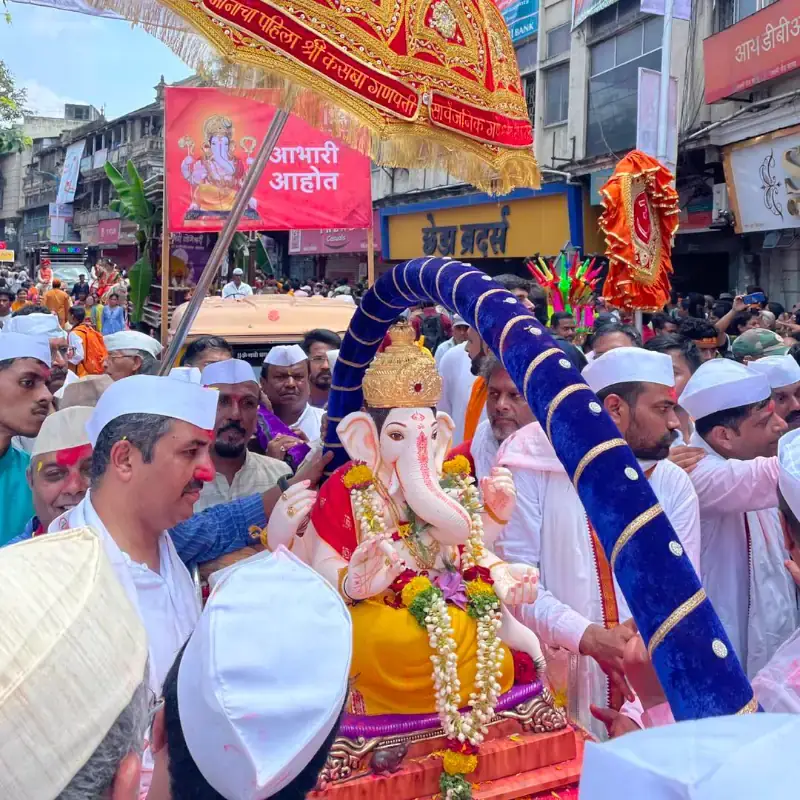
3. Ganesh Chaturthi: A City United in Celebration
➨ 10 Days of Devotion
From devotional songs (Aartis) to dance dramas, the temple’s Mandap buzzes with energy. On Anant Chaturdashi, the immersion procession sees lakhs of devotees chanting “Ganpati Bappa Morya!” as Kasba Ganapati leads the parade.
➨ Cultural Analysis: The festival bridges Pune’s past and present. Young artists perform Lavani (Maharashtrian Folk Dance), while tech professionals volunteer for logistics—a blend of tradition and modernity.
4. Travel Toolkit: Planning Your Pilgrimage
➨ Distance from Major Cities
❉ Mumbai: 150 km (3 hrs by road, frequent trains from CSTM).
❉ Bengaluru: 840 km (12-hr drive, daily flights to Pune).
❉ Delhi: 1,400 km (2-hr flight, 18-hr train journey).
→ Best Time to Visit: October–March (cool weather) or during Ganesh Chaturthi (August–September).
➨ Nearby Attractions
❉ Shaniwar Wada: 2 km away, the Peshwa’s fortress.
❉ Dagdusheth Halwai Temple: 3 km, famed for its gold-plated idol.
➨ Local Markets
❉ Tulshi Baug: Vibrant bazaar for traditional Nath (Nose rings) and Paithani sarees.
❉ FC Road: Foodies flock here for Misal Pav and Bakarvadi.

5. Cultural Deep Dive: Pune’s Soul Beyond the Temple
➨ Demographics:
❉ Talukas: Pune City, Haveli, Mulshi.
❉ Languages: Marathi (70%), Hindi, English.
❉ Economy: Education, IT, and manufacturing hubs.
➨ Local Interview: “Our family has managed a Pithale Bhakri stall near the temple for 50 years. The Ganapati is like a family elder guiding us”, says vendor Raju More.
➨ Monsoon Itinerary:
❉ Day 1: Temple visit + coffee at nearby Kayani Bakery.
❉ Day 2: Trek to Sinhagad Fort (30 km away) in lush rains.
6. FAQs
Is photography allowed inside the temple?
Yes, but avoid flash during rituals.
Entry fee?
Free; donations accepted.
Festival dates for 2025?
August 27th 2025 (Ganesh Chaturthi).
➤ Conclusion
Kasba Ganapati isn’t just a temple—it’s Pune’s living chronicle. From Jijabai’s piety to Tilak’s patriotism, every brick whispers tales of resilience. Whether you seek blessings, history, or cultural immersion, this temple promises an unforgettable journey.
➤ Sources:
❉ Maharashtra Tourism Board
❉ Interviews with local historians and devotees.
❉ Image Credit – Wikimedia Commons & Instagram
“Ganpati Bappa Morya—Pudhchya Varshi Lavkar Ya!” (Come soon next year, O Lord Ganesha!) 🌺
For more information, you can visit our website: ExploreXP


